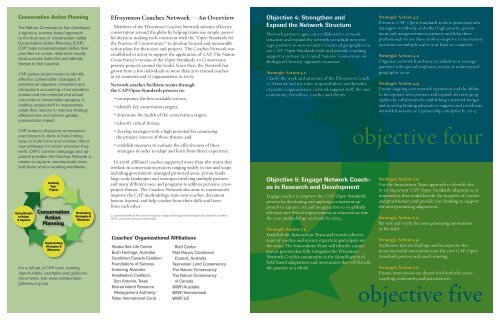Efroymson Coaches Network: - Conservation Gateway
Efroymson Coaches Network: - Conservation Gateway
Efroymson Coaches Network: - Conservation Gateway
Create successful ePaper yourself
Turn your PDF publications into a flip-book with our unique Google optimized e-Paper software.
<strong>Conservation</strong> Action PlanningThe Nature Conservancy has developeda rigorous, science-based approachto the business of conservation called<strong>Conservation</strong> Action Planning (CAP).CAP helps conservationists define theirpriorities for action, determine exactlywhat success looks like and identifythreats to that success.CAP guides project teams to identifyeffective conservation strategies. Itprovides an objective, consistent andtransparent accounting of conservationactions and the intended and actualoutcomes of conservation projects. Itenables project staff to responsivelyadapt their actions to improve strategyeffectiveness and achieve greaterconservation impact.CAP works to discipline conservationpractitioners to think in hard-hittingways to build focus and uncover criticalnew pathways for action wherever theywork. CAP’s common language and approachprovides the <strong>Coaches</strong> <strong>Network</strong> ameans to capture, communicate, learnand share what is working worldwide.Using Resultsto Adapt& ImproveDefiningYourProject<strong>Conservation</strong>ActionPlanningImplementingStrategies &MeasuresDevelopingStrategies &MeasuresFor a full set of CAP tools, trainingopportunities, examples and guidancedocuments, visit www.conservationgateway.org/cap.<strong>Efroymson</strong> <strong>Coaches</strong> <strong>Network</strong> — An OverviewMembers of the <strong>Efroymson</strong> <strong>Coaches</strong> <strong>Network</strong> advance effectiveconservation around the globe by helping teams use simple, powerfuldecision-making tools consistent with the “Open Standards forthe Practice of <strong>Conservation</strong>” 4 to develop focused and measurableaction plans for their sites and projects. The <strong>Coaches</strong> <strong>Network</strong> wasestablished in 2004 to support the application of CAP, The NatureConservancy’s version of the Open Standards, to Conservancypriority projects around the world. Since then, the <strong>Network</strong> hasgrown from a few individuals to more than 200 trained coachesin 29 countries and 15 organizations in 2009.<strong>Network</strong> coaches facilitate teams throughthe CAP/Open Standards process to:• incorporate the best available science,• identify key conservation targets,• determine the health of the conservation targets,• identify critical threats,• develop strategies with a high potential for counteringthe primary sources of those threats, and• establish measures to evaluate the effectiveness of thesestrategies in order to adapt and learn from direct experience.In 2008, affiliated coaches supported more than 180 teams thatworked on conservation projects ranging widely in size and scope,including government-managed protected areas, private lands,large-scale landscapes and seascapes involving multiple partnersand many different uses, and programs to address pervasive crossprojectthreats. The <strong>Coaches</strong> <strong>Network</strong> also aims to continuouslyimprove the CAP methodology, train new coaches, documentlessons learned, and help coaches hone their skills and learnfrom each other.4 A general framework for conservation project design and management developed and adopted by membersof the <strong>Conservation</strong> Measures Partnership.<strong>Coaches</strong>’ Organizational AffiliationsAlaska Sea Life CenterBush Heritage, AustraliaCarolinian Canada CoalitionFoundations of SuccessGreening AustraliaHeadwaters Coalition,San Antonio, TexasKosrae Island ResourceManagement AuthorityPalau International CoralReef CenterPeel Harvey CatchmentCouncil, AustraliaTasmanian Land ConservancyThe Nature ConservancyThe Nature Conservancyof CanadaWWF/AustraliaWWF/InternationalWWF/USObjective 4: Strengthen andExpand the <strong>Network</strong> Structure<strong>Network</strong> partners agree on a collaborative networkstructure and expand the network to include new strategicpartners in new or under-resourced geographies touse CAP/Open Standards tools and provide coachingsupport in at least 20 United Nations’ Convention onBiological Diversity signatory countries.Strategic Action 4.1:Clarify the work and structure of the <strong>Efroymson</strong> <strong>Coaches</strong><strong>Network</strong> and the roles, responsibilities and benefitsof partner organizations, network support staff, the usercommunity, franchises, coaches and clients.Objective 5: Engage <strong>Network</strong> <strong>Coaches</strong>in Research and DevelopmentEngage coaches to improve the CAP/Open Standardsprocess by developing and applying a consistent approachto capture, vet and integrate five to 10 globallyrelevant user-driven improvements or innovations intothe core methodology and tools by 2012.Strategic Action 5.1:Establish the Innovations Team and recruit a diverseteam of coaches and science experts to participate onthe team. The Innovations Team will identify a transparentprocess that fully integrates the <strong>Efroymson</strong><strong>Network</strong> <strong>Coaches</strong> community in the identification offield-based adaptations and innovations that will benefitthe practice as a whole.Strategic Action 4.2:Promote CAP/Open Standards tools to protected areamanagers worldwide and other high priority governmentand nongovernment partners and help theseprofessionals to use these tools to improve conservationoutcomes at multiple scales in at least 20 countries.Strategic Action 4.3:Organize network franchises to include new strategicpartners with special emphasis on new or underservedgeographic areas.Strategic Action 4.4:Ensure ongoing core network operations and the abilityto incorporate new partners and expand into new geographiesby collaboratively establishing a network budgetand securing funding adequate to support and coordinatenetwork functions as a partnership enterprise by 2012.objective fourStrategic Action 5.2:Use the Innovations Team approach to identify fiveto 10 important CAP/Open Standards adaptations orinnovations that would benefit the majority of coachesand practitioners and provide core funding to supportthe most promising adaptations.Strategic Action 5.3:Re-test and verify the most promising innovationsin the field.Strategic Action 5.4:Synthesize test site findings and incorporate themost successful innovations into the core CAP/OpenStandards process and coach training.Strategic Action 5.5:Ensure innovations are shared with both the activecoaching community and practitioners.objective five
















